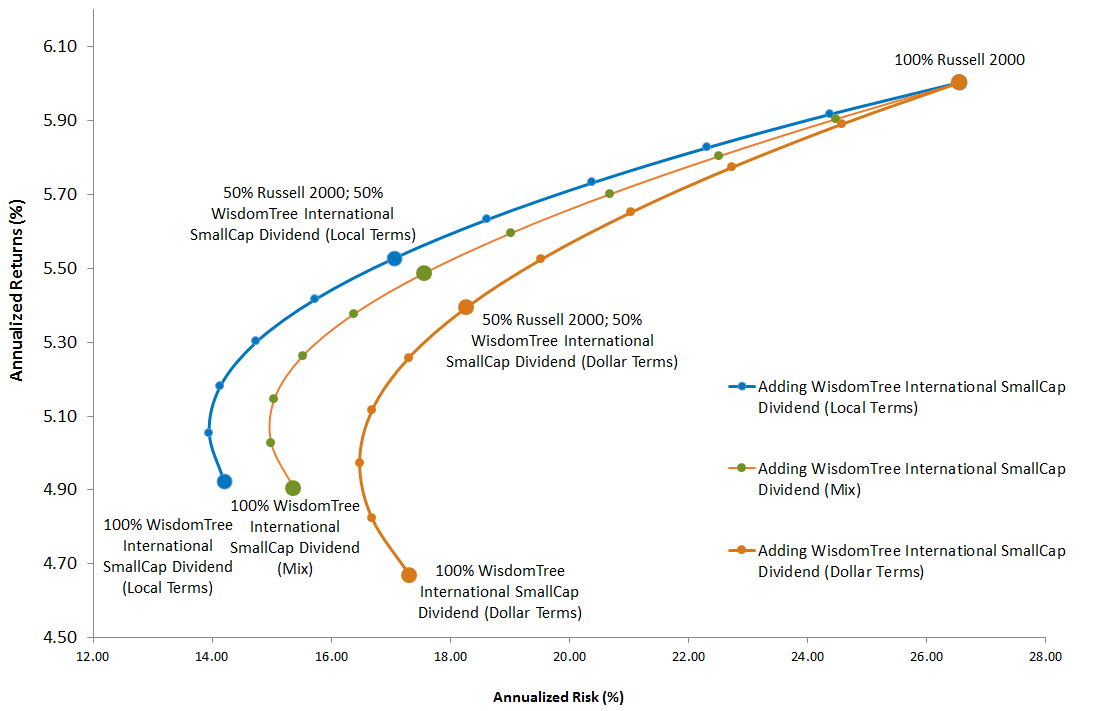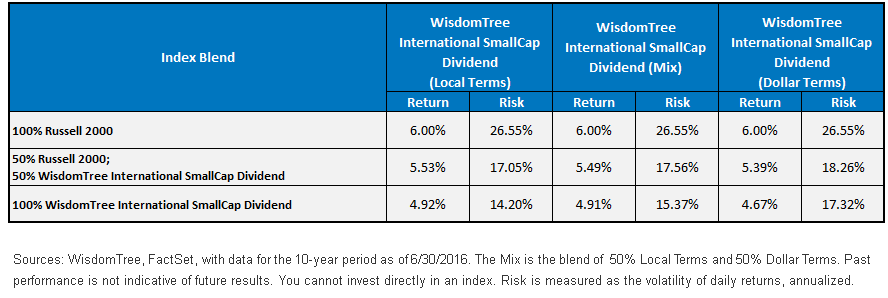Why Diversification Is Not Dead: A Small Cap Example



 Currency Hedging Could Reduce Risk Further
The analysis above is not even the lowest-risk way of investing in international small caps, in our view. That analysis assumes investors took currency risk unhedged, as has been the case for years.
More recently, WisdomTree has advocated that investors consider either full passive currency-hedged strategies or, more recently, dynamic hedged strategies that can raise or lower the currency-hedge ratio based on proprietary signals implemented once per month. WisdomTree has Indexes for developed international small caps that include both passive hedging and dynamic hedging.
The data above illustrates that hedging currency risk (shown in the difference between local and U.S. dollar index returns) to focus on the returns for international stocks without added currency could further reduce risk.
The international small-cap stocks, measured without currency impact, had a volatility of 14.2%, while the stocks with the currency impact had a volatility of about 17.3%.
What’s interesting about this is the 14.2% volatility of the international small-cap dividend payers— there is a dramatic almost 50% volatility reduction on international small caps looking at these stocks without the currency impact and judging relative to the 26.55% average annual risk seen with the Russell 2000.
Some investors believe there is a diversification benefit that comes with having currency exposure unhedged. The combinations of U.S. small-cap stocks with international small-cap dividend payers shown here casts doubt on that premise. The lowest-risk combination was the Russell 2000 with international small caps (without currency), and currency risk failed to provide any real “diversification” benefits. Adding international stocks on top of U.S. stocks did, however, help lower volatility significantly compared to being allocated to U.S. small-cap stocks only.
Conclusion
While some investors look at the recent past and conclude “Who needs global allocations when U.S. companies operate all over the world?” the analysis presented here shows that in the small-cap arena, there are significant benefits from a risk mitigation perspective to allocate to international small-cap dividend payers combined with the Russell 2000.
And if my expectation proves correct and the past decade of U.S. dominance over international markets reverts, there would be a further benefit that these lower risk levels could come with higher returns as well.
1Source: Bloomberg, with data from 8/31/2006 to 8/31/2016.
2Sources: WisdomTree, Bloomberg, with data as of 8/31/2016. Refers to companies that did not pay any dividends in the 12 months prior to 8/31/2016 and companies that do not have a trailing 12-month trailing 12-month P/E ratio as of 8/31/2016. Past performance is not indicative of future results. You cannot invest directly in an index.
Currency Hedging Could Reduce Risk Further
The analysis above is not even the lowest-risk way of investing in international small caps, in our view. That analysis assumes investors took currency risk unhedged, as has been the case for years.
More recently, WisdomTree has advocated that investors consider either full passive currency-hedged strategies or, more recently, dynamic hedged strategies that can raise or lower the currency-hedge ratio based on proprietary signals implemented once per month. WisdomTree has Indexes for developed international small caps that include both passive hedging and dynamic hedging.
The data above illustrates that hedging currency risk (shown in the difference between local and U.S. dollar index returns) to focus on the returns for international stocks without added currency could further reduce risk.
The international small-cap stocks, measured without currency impact, had a volatility of 14.2%, while the stocks with the currency impact had a volatility of about 17.3%.
What’s interesting about this is the 14.2% volatility of the international small-cap dividend payers— there is a dramatic almost 50% volatility reduction on international small caps looking at these stocks without the currency impact and judging relative to the 26.55% average annual risk seen with the Russell 2000.
Some investors believe there is a diversification benefit that comes with having currency exposure unhedged. The combinations of U.S. small-cap stocks with international small-cap dividend payers shown here casts doubt on that premise. The lowest-risk combination was the Russell 2000 with international small caps (without currency), and currency risk failed to provide any real “diversification” benefits. Adding international stocks on top of U.S. stocks did, however, help lower volatility significantly compared to being allocated to U.S. small-cap stocks only.
Conclusion
While some investors look at the recent past and conclude “Who needs global allocations when U.S. companies operate all over the world?” the analysis presented here shows that in the small-cap arena, there are significant benefits from a risk mitigation perspective to allocate to international small-cap dividend payers combined with the Russell 2000.
And if my expectation proves correct and the past decade of U.S. dominance over international markets reverts, there would be a further benefit that these lower risk levels could come with higher returns as well.
1Source: Bloomberg, with data from 8/31/2006 to 8/31/2016.
2Sources: WisdomTree, Bloomberg, with data as of 8/31/2016. Refers to companies that did not pay any dividends in the 12 months prior to 8/31/2016 and companies that do not have a trailing 12-month trailing 12-month P/E ratio as of 8/31/2016. Past performance is not indicative of future results. You cannot invest directly in an index.
Important Risks Related to this Article
Foreign investing involves special risks, such as risk of loss from currency fluctuation or political or economic uncertainty.
Diversification does not eliminate the risk of experiencing investment losses.
Dividends are not guaranteed, and a company currently paying dividends may cease paying dividends at any time.
Hedging can help returns when a foreign currency depreciates against the U.S. dollar, but it can hurt when the foreign currency appreciates against the U.S. dollar.

Jeremy Schwartz has served as our Global Chief Investment Officer since November 2021 and leads WisdomTree’s investment strategy team in the construction of WisdomTree’s equity Indexes, quantitative active strategies and multi-asset Model Portfolios. Jeremy joined WisdomTree in May 2005 as a Senior Analyst, adding Deputy Director of Research to his responsibilities in February 2007. He served as Director of Research from October 2008 to October 2018 and as Global Head of Research from November 2018 to November 2021. Before joining WisdomTree, he was a head research assistant for Professor Jeremy Siegel and, in 2022, became his co-author on the sixth edition of the book Stocks for the Long Run. Jeremy is also co-author of the Financial Analysts Journal paper “What Happened to the Original Stocks in the S&P 500?” He received his B.S. in economics from The Wharton School of the University of Pennsylvania and hosts the Wharton Business Radio program Behind the Markets on SiriusXM 132. Jeremy is a member of the CFA Society of Philadelphia.

